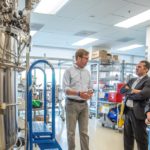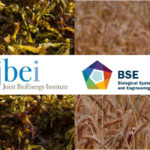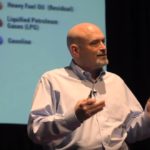 Blake Simmons, Director of the Biological Systems and Engineering Division, gave a talk at TEDxSonomaCounty on November 4, 2017 entitled “A World Without Limits through Biomanufacturing of Carbon”. The video of the talk is now available.
Blake Simmons, Director of the Biological Systems and Engineering Division, gave a talk at TEDxSonomaCounty on November 4, 2017 entitled “A World Without Limits through Biomanufacturing of Carbon”. The video of the talk is now available.
DOE Under Secretary for Science Paul Dabbar Visits Biosciences Area
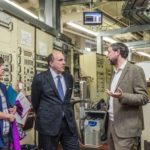 Paul Dabbar, Department of Energy’s Under Secretary for Science, visited Berkeley Lab on January 18. The visit focused namely on the Lab’s industry engagement programs. During the visit, Dabbar heard presentations by Mary Maxon, Associate Lab Director for Biosciences, and Blake Simmons, Division Director for Biological Systems and Engineering. Paul Adams, Division Director for Molecular Biophysics & Integrated Bioimaging welcomed Dabbar at the Advanced Light Source, and Todd Pray, Program Head of the Advanced Biofuels and Bioproducts Development Unit gave a tours of its facilities. The visit also included tours of the Integrative Genomics Building construction site and the Joint Bioenergy Institute.
Paul Dabbar, Department of Energy’s Under Secretary for Science, visited Berkeley Lab on January 18. The visit focused namely on the Lab’s industry engagement programs. During the visit, Dabbar heard presentations by Mary Maxon, Associate Lab Director for Biosciences, and Blake Simmons, Division Director for Biological Systems and Engineering. Paul Adams, Division Director for Molecular Biophysics & Integrated Bioimaging welcomed Dabbar at the Advanced Light Source, and Todd Pray, Program Head of the Advanced Biofuels and Bioproducts Development Unit gave a tours of its facilities. The visit also included tours of the Integrative Genomics Building construction site and the Joint Bioenergy Institute.
Director of the CA Governor’s Office of Business Visits Biosciences Area
 Panorea Avdis, Director of Governor Brown’s Office of Business and Economic Development (GO-Biz), visited the Biosciences Area’s Emery Station Operations Center on September 6 to learn more about the biosciences and bioeconomy related initiatives. GO-Biz was created to serve as California’s single point of contact for economic development and job creation efforts and is an important one-stop shop for companies that want to take advantage of California incentives.
Panorea Avdis, Director of Governor Brown’s Office of Business and Economic Development (GO-Biz), visited the Biosciences Area’s Emery Station Operations Center on September 6 to learn more about the biosciences and bioeconomy related initiatives. GO-Biz was created to serve as California’s single point of contact for economic development and job creation efforts and is an important one-stop shop for companies that want to take advantage of California incentives.
JBEI/BSE Paper Among PLOS ONE Top 10% Most Cited Articles
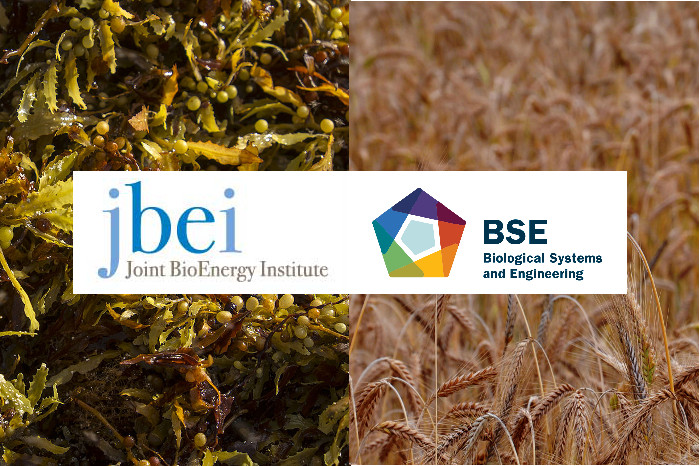 A paper by Joint BioEnergy Institute (JBEI) and Biological Systems and Engineering (BSE) researchers has been ranked among the top 10% most cited PLOS ONE articles. “A Thermophilic Ionic liquid-tolerant Cellulase Cocktail for the Production of Cellulosic Biofuels” published in 2012 has already been viewed 8,871 times and cited 50 times as of today. The paper reports the development of an Ionic Liquid-tolerant cellulase cocktail by combining thermophilic bacterial glycoside hydrolases produced by a mixed consortia with recombinant glycoside hydrolases.
A paper by Joint BioEnergy Institute (JBEI) and Biological Systems and Engineering (BSE) researchers has been ranked among the top 10% most cited PLOS ONE articles. “A Thermophilic Ionic liquid-tolerant Cellulase Cocktail for the Production of Cellulosic Biofuels” published in 2012 has already been viewed 8,871 times and cited 50 times as of today. The paper reports the development of an Ionic Liquid-tolerant cellulase cocktail by combining thermophilic bacterial glycoside hydrolases produced by a mixed consortia with recombinant glycoside hydrolases.
Papers by JBEI/BSE Researchers Among Journal’s Most Impactful Articles
Two papers by Joint BioEnergy Institute (JBEI) and Biological Systems and Engineering (BSE) researchers are currently ranked among the most popular articles published in the journal BioEnergy Research. “An Investigation on the Economic Feasibility of Macroalgae as a Potential Feedstock for Biorefineries,” published in in 2015, is among the most downloaded, and “Assessment of Lignocellulosic Biomass Using Analytical Spectroscopy: an Evolution to High-Throughput Techniques,” published in 2014, is among the most cited. In the former paper, the authors—Murthy Konda, Seema Singh, Blake Simmons, and the late Daniel Klein-Marchschamer—presented a detailed technoeoconomic analysis of the economic potential and cost drivers of macroalgae as a feedstock for the production of biofuels and biochemicals. In the latter, Jason Lupoi, Singh, and Simmons undertook a comparative review of rapid, high-throughput spectroscopic techniques and standard, more time-intensive techniques to analyze candidate terrestrial biomass feedstocks for desirable traits.
Was this page useful?


